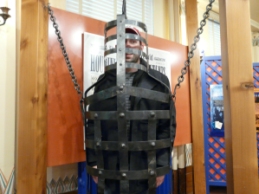No jail cell or straight jacket could hold him! He shucked off handcuffs as easily as gloves. – Sid Fleischman (Escape! The Story of the Great Houdini)
Challenges and Successes: Online Communities of Practice by Ann Ware (Ed Tech: Focus on K-12, Winter 2015)
The role of the school leader has always been an isolating position. Ware observes this, noting that we often “work autonomously and feel geographically isolated”. She strongly recommends Google+ Communities as a tool of choice for the busy educator looking to better connect with other professionals. Ware offers clear guidelines for these third spaces for learning:
- The community of practice should acknowledge the needs and interests highlighted by members.
- Social media should be leveraged to support collaboration.
- One member should be appointed as the community of practice leader.
She also suggests that communities of practice regularly self-assess the impact they are having on the participants, through such measures as analytics and polls.
The Authenticity Paradox: Why feeling like a fake can be a sign of growth by Herminia Ibarra (Harvard Business Review, January/February 2015)
Authenticity is defined in this article as “an original, not a copy”. This concept is a hot topic in many discussions about management. It has become “the gold standard of leadership”, primarily because it describes that agreement between leaders being open about their abilities and still maintaining authority within their organization. Social media is but one area in which this balancing act takes place.
By viewing ourselves as works in progress and evolving our professional identities through trial and error, we can develop a personal style that feels right to us and suits our organizations’ changing needs.
There seems to be little divide between our in-person interactions and how we represent ourselves online. The lines are blurry because so much of what we share about ourselves now is broadcasted for the world to see. “How we present ourselves – not just as executives but as people, with quirks and broader interests – has become an important aspect of leadership.”
Why a Great Principal Burned Out – and What Might Have Helped by Ellie Herman (Gatsby in L.A., July 11, 2014)
A writing teacher grieves over the departure of a principal and a friend who, by all accounts, was a very effective school leader in his three year tenure with the Los Angeles Public School System. She asked the question: Why would such a talented principal choose to leave the job? Here is what he had to share:
What’s so hard is keeping yourself open to 600-plus students, over 100 adults on campus, the parents, the community…there’s no rest, there’s no stop. How many things can happen in a day? At the end of every day I’ve heard six things that I’m not okay with, a kid who stabbed another kid with a pencil, a parent who called a kid out of class and hit him with an extension cord, I hated sending kids out on a 5150 [mental illness designation].
This example of extreme and constant stress led to the principal’s decision to go back to the classroom. Herman acknowledges as much, and also concludes by asking: “When are we going to stop demanding accountability without also demanding sustainable working conditions?”
Stop Checking Email So Often by Kostadin Kushlev and Elizabeth W. Dunn (New York Times, January 9, 2015)
Is email overload bad for you?
“Hmmm” says this principal, who always seems to have 20-30 messages floating in his own inbox. Kushlev and Dunn take a different approach to the usual blaming of email itself, and instead wonder whether it is the frequency in which we check email that is the culprit. In a study they conducted, professionals were separated into two groups. One group was instructed to check their email as frequently as possible. The other group could only check their email three times a day.
The results: Groups that checked their email as much as possible reported higher levels of stress compared to the restricted email group. Those professionals that were part of the limited email rules reported reductions in stress similar to people who applied stress-reduction techniques, such as deep breathing.
Swan Song (Techlandia Podcast #73, September 10, 2014)
Hosts Curt Rees, Allison Anderson, and Jon Samuelson talk with Shawn White about his teaching and writing experience on their weekly podcast. This entry is titled “Swan Song” because both Curt and Allison bid farewell to Techlandia, citing a need to find more balance between their professional and personal lives. Curt brought this topic into focus, asking each educator to describe their perfect Saturday. Common threads included time with family and personal interests.
You can listen to the entire podcast here:
[youtube https://www.youtube.com/watch?v=_AoIKmpGOFE]
Taking a step back…
 Today’s post is especially relevant for the topic. Yesterday (Saturday) is the day I usually put my final thoughts together and then publish. However, I had promised my son that we would visit the Houdini exhibit at an historical museum in Appleton, Wisconsin. We have been reading the biography Escape! The Story of the Great Houdini by Sid Fleischman. He was excited to view some of the artifacts we have read about first hand. How could I say no?
Today’s post is especially relevant for the topic. Yesterday (Saturday) is the day I usually put my final thoughts together and then publish. However, I had promised my son that we would visit the Houdini exhibit at an historical museum in Appleton, Wisconsin. We have been reading the biography Escape! The Story of the Great Houdini by Sid Fleischman. He was excited to view some of the artifacts we have read about first hand. How could I say no?

We had a lot of fun exploring the museum, picking locks and discovering more about the man’s life. It is an interesting title for the book (Escape!). It references more than just Houdini’s amazing exploits. Growing up, he had to escape abject poverty. As a fledgling magician, it took him years and countless failures to break free of preconceived notions of his profession, often viewed as no more than a circus sideshow. Houdini also struggled with his own ego, particularly with the desire to push boundaries and to be recognized as the best.
As school leaders, we also deal with these elements – poverty, failure, striving for success – on a daily basis. Maybe not to the degree that Houdini experienced, but they are certainly present in our professional and personal lives. We have an endless stream of emails to check, student issues to sort out, and images of our school and ourselves to uphold. I know exactly how that L.A. principal felt when he stated “there is no rest, no stop”.
Yet, some of these very connections that we form both in person and online can also help us get off “admin island”. Positions of school leadership can be very isolating, much more so than any other areas in education. We need all the help we can get. For me, I am so thankful for the communities of practice I am a part of on Google+ and Voxer. The people that make up these learning communities provide both perspective and support. They also allow me to be authentic, shedding some of my principal persona and just be real. I have even started podcasting with other school leaders, to explore ways to find balance.

So while these positions can be overwhelming at times, I don’t want to escape from the bindings that are both a part of the job and self-imposed. Yes, I certainly need to find time for myself, my family and friends. If I am always connected, have I ever left the office? I am learning that the key to balance is prioritizing what’s most important, because when I say yes to one thing, I am saying no to something else.

One response to “The Networking, Ever-Present, Highly Connected School Leader”
[…] the podcast, we will discuss three articles I summarized from a previous post here at Theory and Practice. This podcast will be broadcasted live, either by clicking here or the […]